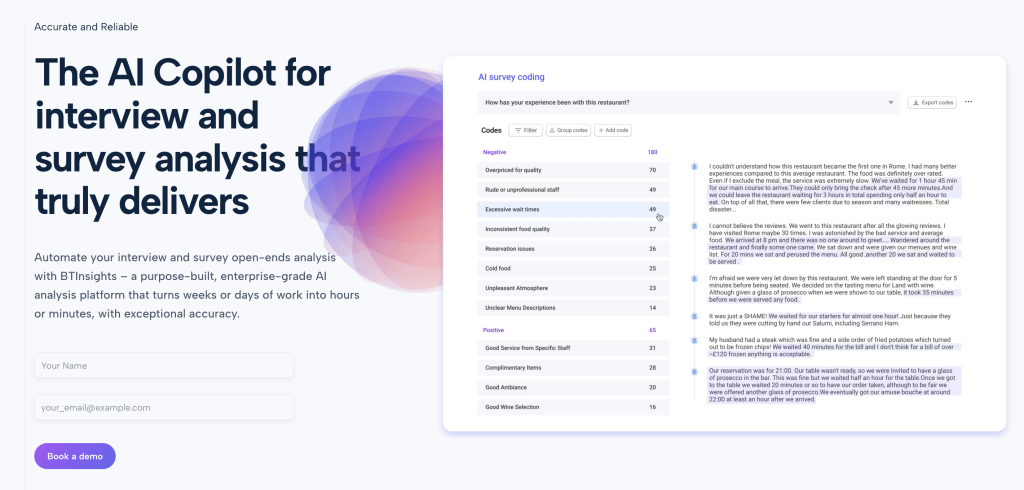Generative AI is revolutionizing survey text analysis. Whether working with focus groups, in-depth interviews (IDIs), or open-ended survey questions, AI text analysis tools can help businesses gain actionable insights faster, deeper, and more accurately than ever before.
But with so many tools on the market, how do you know which one is right for your business? And how is generative AI different from older text analysis methods?
In this guide, we’ll cover the key capabilities of generative AI, what to look for in a text analysis platform, and how to choose the right solution for your needs.
Why AI Is a Game-Changer for Survey Text Analysis
Generative AI models like OpenAI’s GPT have pushed the state-of-the-art in text analytics forward by leaps and bounds. Rather than simply tagging keywords or relying on rule-based classification, modern LLMs deliver insights that are much richer, more accurate, and more actionable. Here are the main ways that generative AI is changing the game in text analysis:
1. Understanding Context and Nuance
Traditional methods: Older tools typically focused on matching to a predefined taxonomy, or simple ML classifiers trained to recognize basic topics or sentiment without appreciating nuance and context.
Generative AI advantage: Generative LLMs are able to understand nuanced language. They can parse key differences between, for example, a neutral sentiment (“This product works”) and an “eh” sentiment (“I guess this product works”) by picking up on language context and emotional cues, driving deeper into the heart of what respondents are saying.
2. Flexibility and Adaptability
Traditional methods: Legacy platforms may still rely on manual configuration of taxonomies and rules, or extensive initial setup to train models.
Generative AI advantage: With generative AI, you are free to “ask” the data for what you want. “What are the key themes across these interviews?” “How has customer sentiment on feature X changed over time?”… ask without manual constraints.
3. Speed and Scalability
Traditional methods: Preprocessing and analyzing large text datasets can still be slow, even with modern computing.
Generative AI advantage: Now the analysis itself, powered by AI, is super-fast. AI can handle thousands of open-ended responses in minutes, providing insights from massive qualitative data sets at real-time speed.
4. From Insights to Action
Traditional methods: Most platforms end with the reporting, leaving data interpretation up to the analyst.
Generative AI advantage: Generative AI models can now do more than report insights — they can generate specific, actionable recommendations to try (e.g., “customers are confused by Feature X — consider these changes to make it more intuitive”).
AI survey open-ends analysis with exceptional accuracy
Let AI generate codes or use your own codebook
What to Look for in an AI Text Analysis Platform
When selecting an AI text analysis platform, there are four main areas to evaluate:
1. The AI Model Itself
The first place to start is the underlying LLM. Here are some key questions to ask:
- What is the model used? OpenAI’s GPT, Anthropic’s Claude, Google’s Gemini, etc? (BTI uses the latest GPT models)
- Which version? Performance/capabilities can vary a lot between model versions, e.g., GPT-3.5 vs. GPT-4.
- Can the model be customized? Fine-tuned on the fly for specific tasks like surveys, customer feedback, etc?
2. Safeguards Against AI Hallucinations
AI hallucinations (making things up) is a concern. You need platforms with:
- Grounded insights: Tie all insights to the original transcripts / source data.
- Confidence/validation layers: Confidence scores, manual review, or verification workflows to catch and review uncertain results.
3. Security and Privacy
Survey data can contain sensitive or proprietary info, so platform security is a priority:
- Data used for training? Do they use client data to train their models? (BTI never uses client data to train or improve our models.)
- Encryption: In transit and at rest
- Compliance: GDPR, HIPPA, CCPA, etc.
4. Usability and Scalability
AI is of limited value if it is not easy to access and use, so consider:
- Ease of use: A tool that non-technical users can run analyses on and generate insights from.
- Scalability: Volume of data can grow, and the solution must scale seamlessly with no tradeoffs.
BTInsights – AI Interview and Survey Analysis Platform

BTInsights combines the power of modern generative AI technology with full grounding and industry-leading security, built from the ground up for survey text analysis and qualitative research.
- AI built for research: BTInsights uses the latest GPT models that have been further fine-tuned for analyzing open-ended survey responses and interviews.
- Fully grounded insights: Every AI-generated insight is traced back to the original transcript for complete transparency and accuracy.
- Best-in-class data protection: BTInsights has a strong commitment to data privacy. We never use client data to train our models and all data is securely encrypted.
The Bottom Line
Generative AI is transforming how organizations approach survey text analysis, enabling a level of understanding, speed, scalability, and actionable insight that was impossible before.
The right AI text analysis platform needs to check four boxes:
- Powerful AI models, with the flexibility to fine-tune for specific research needs
- Built-in safeguards to guard against AI hallucinations and generate grounded insights
- Robust security and privacy measures for handling sensitive client data
- Usability and scalability to ensure research teams can use the tools effectively.
BTI brings all these capabilities together to help research teams turn raw qualitative data into strategic business insights – faster, more accurately, and at scale.
AI survey open-ends analysis with exceptional accuracy
Let AI generate codes or use your own codebook

